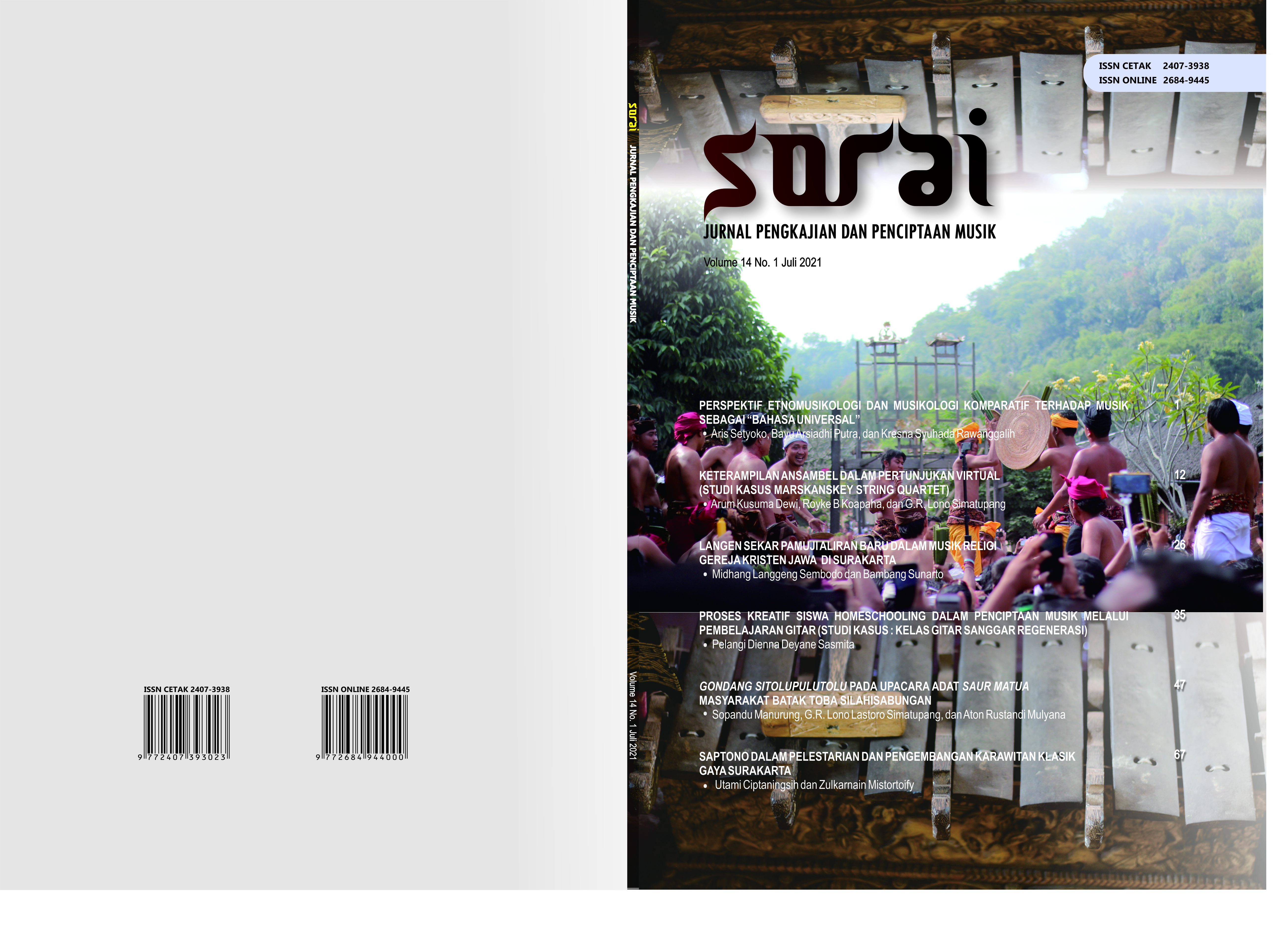GONDANG SITOLUPULUTOLU PADA UPACARA ADAT SAUR MATUA MASYARAKAT BATAK TOBA SILAHISABUNGAN
Main Article Content
Abstract
Gondang Sitolupulutolu is a gondang ensemble that can only be found in the Toba Batak community. They are Silalahisabungan clan group. Gondang sitolupulutolu is very important in the Silahisabungan community because it can not be separeted from the traditional ceremonies. This study aims to determine how the use and function of the gondang sitolupulutolu in one of the traditional ceremonies of the Silahisabungan community, namely saur matua. This study use a qualitative method. Alan P. Meriam’s (1964) theory of use and function was chosen to see the use and function of the gondang sitolupulutolu. The results showed that the Gondang Sitolupulutolu was used at the opening ceremony during the manortor (ceremonial dance) and at the end of ceremony (closing ceremony). While the function of the gondang sitolupulutolu at the traditional ceremony of Saur Matua is as an expression of joy and sorrow, as entertainment, as a means of communication to convey prayers to God, as a symbol, and as a validation of the Saur Matua traditional ceremony.
Downloads
Article Details
Copyright
Authors who publish to Sorai: Jurnal Pengkajian dan Penciptaan Musik agrees to the following terms:
- Authors retain copyright and grant the journal right of first publication with the work simultaneously licensed under a Creative Commons Attribution License (CC BY-SA 4.0) that allows others to share the work with an acknowledgment of the work's authorship and initial publication in this journal.
- Authors can enter into separate, additional contractual arrangements for the non-exclusive distribution of the journal's published version of the work (e.g., post it to an institutional repository or edit it in a book), with an acknowledgment of its initial publication in this journal.
- Authors are permitted and encouraged to post their work online (e.g., in institutional repositories or on their website) before and during the submission process, as it can lead to productive exchanges, as well as earlier and greater citation of published work.
References
Hutagalung, WH. 1991. Pustaha Batak: Tarombo Dohot Turiturian ni Bangso Batak. Jakarta: Tulus Jaya.
Hutajulu, Rithaony dan Irwansyah Harahap. 2005. Gondang Batak Toba. Bandung: P4ST UPI.
Meriam, Allan P. 1975[1964]: The Anthropologi of Music. Chokago: North Western University Pres
Nazir, Muhammad. 2005. Metode Penelitian. Jakrta. Ghalia Indonesia.
Netl, Bruno. 1964. Theory and Method in Etnomusicology. New York. Macmillan
Purba, Anggiat. 2013. Gondang Sitolupulutolu Dalam Upacara Pesta Tugu Silahisabungan. Skripsi Sarjana. ISI Yogya.
______, 2013. Purba, Anggiat. 20013. Gondang Sitolupulutolu Dalam Upacara Pesta Tugu Silahisabungan. Jurnal Selonding. Vol 3. No 3. Hal 265-288
Purba, Mauly. 2014. Musik Tiup dan Upaara Adat: Kasus Pengayaan Identitas Kebudayaan Musikal pada Masyarakat Batak Toba di Kota Medan. Jurnal Panggung. Vol. 24 No. 3 Hal 258-274.
______. 2004. “Mengenal Tradisi Gondang dan Tortor Pada Masyarakat Batak Toba,” dalam Pluralitas Musik Etnik: Batak Toba, Mandailing, Melayu, Pakpak-Dairi, Angkola, Karo, dan Simalungun. Ben M. Pasaribu (ed.). Medan: Pusat Dokumentasi dan Pengkajian Kebudayaan Batak Universitas HKBP Nommensen.
Sigalingging, Sarmaida T.R. 2013. Struktur dan Nilai Budaya Batak Toba dalam Sastra Lisan Huta Silahisabungan. Jurnal Sasindo.Vol. 2 No. 4.
Sihaloho, J. 2000. Memori Tumaras: Tugu dan Makam Raja Silahisabungan di Silalahi Nabolak. Sebuah Cataan Sejarah (tidak titerbitkan)
Sinaga, Fertika. 2018. Cerita Tugu Silahisabungan: Kajian Sosiologis. Sebuah Skripsi Sarjana. USU Medan.
Simangunsong, Emmi. 2013. Perubahan dan Kesinambungan Tradisi Gondang dan Tortor Dalam Pesta Adat Perkawinan Pada Masyarakat Batak Toba di Medan. Jurnal Visi. Vol 20. Hal 1412-1414
Sinurat, Irma Juniat. 2014. Fungsi Pesta Luhutan Bolon Tugu Raja Silahisabungan dalam Mempertahankan Integritas Sosial Pomparan Raja Silahi Sabungan. Skripsi Sarjana. USU Medan.
Tanjung, Markus P.T. 2000. Studi Organologi Sarune Ensambel Gondang Sitolupulutolu Dalam Tradisi Musik Masyarakat Keturunan Raja Silahi sabungan di Desa Silahi Nabolak Kecamatan Sumbul Kabupaten Dairi. Skripsi Sarjana. USU Medan.
Vergouwen, J.C. 2004[1986]. Masyarakat dan Hukum Adat Batak Toba (Terjemahan). Jakarta: LKIS
